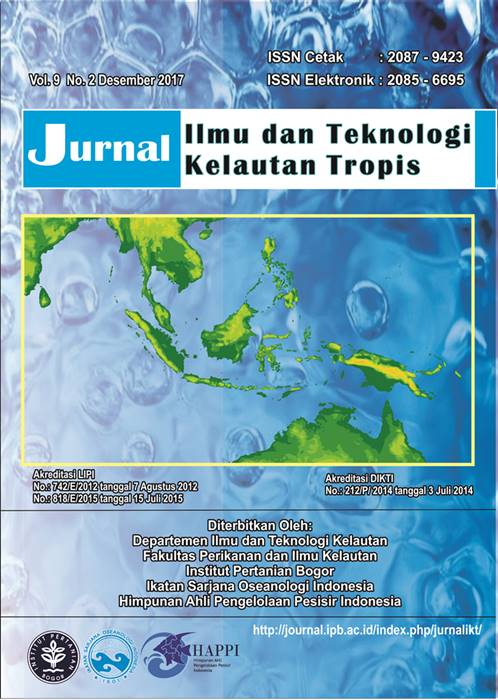SUITABILITY OF LOCATION FOR RESTOCKING CLAMS TRIDACNIDAE IN THE SPERMONDE ARCHIPELAGO
Abstract
Efforts to protect giant clams from extinction one of them through conservation, which set a region as a restocking area. The research aimed to analyze the suitability environments with the density giant clams in the aquatic. The research conducted in September 2013-January 2014. The research site was determined by purposive sampling of middle inner zone = MIZ, middle outer zone = MOZ, and outer zone = OZ in the aquatic of Spermonde Archipelago. The research conducted was using observation method of biology, physics, and chemistry parameters of aquatic at mintakat reef flats, reef slope and reef base. Data analysis of location suitability of restocking giant clams using WSM method (and correlation analysis of giant clams density with water quality, then integrated with ALOS Avnir-2 image. The result research shows the density giant clams influenced by the physical environment parameters, mainly salinity, brightness and depth. The suitability location of restocking giant clams for class Very suitable in P. Langkadea and P. Pala (MOZ), P. Cangke (OZ), P. Tambakulu and P. Kondongbali (OZ) on mintakat reef flats. Class Very suitability on reef slope in P. Kondongbali and P. Kapoposang (OZ). Class accordance with the reef flats, there are P. Podang Podang Lompo (MOZ), P. Sarappo Keke (OZ) and P. Kapoposang (OZ). Class Appropriate to reef slope mintakat in P. Langkadea (MOZ) and P. Sarappo Keke (OZ). Determination of giant clams restocking area in nature needs considers the location suitability, primarily the quality of aquatic physics.
Keywords: conservation, clam, weight sum model, ALOS Avnir-2 image
Authors
The author submitting the manuscript must understand and agree that the copyright of the article manuscript must be submitted/transferred to the Jurnal Ilmu dan Teknologi Kelautan Tropis. This work is licensed under the Creative Commons Attribution-ShareAlike 4.0 (CC BY-SA) International License in which the Author and Reader can copy and redistribute the material in any media or format, and remix, modify and build material for any purpose, but they must provide appropriate credit (citing articles or content), provide a link to the license, and indicate whether there is a change. If you mix, change, or create material, you must distribute your contribution under the same license as the original.


